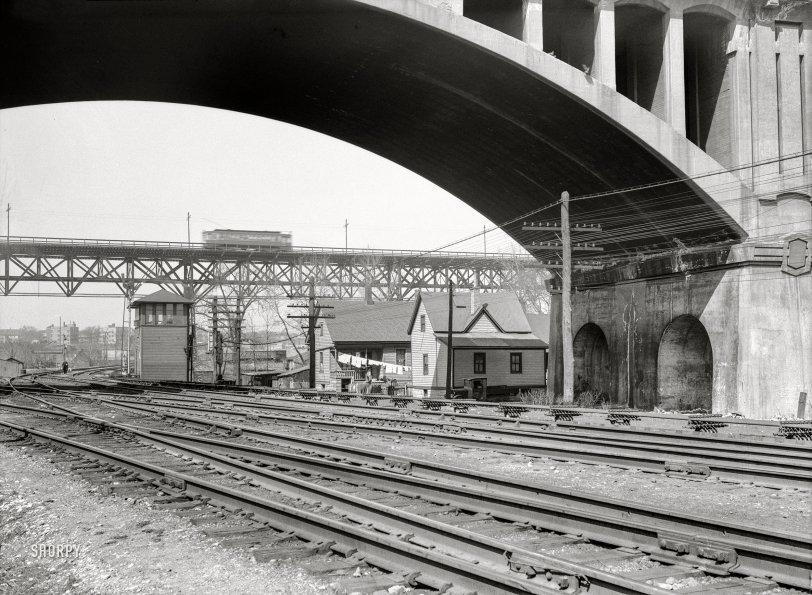


Framed or unframed, desk size to sofa size, printed by us in Arizona and Alabama since 2007. Explore now.
Shorpy is funded by you. Patreon contributors get an ad-free experience.
Learn more.

- Lofty addition
- In 1912
- Keenan Building
- Six years old
- Taken from the P.J. McArdle Roadway?
- It stood only 47 years
- Three track mind
- Incline to the right
- Reach for the sky, 1912 style
- No clean sweep
- Same Job Title, Same Face
- Sadly Lost
- Beautiful ...
- Where you get your kicks
- Aim High
- Pueblo Revival sisters
- Pueblo Neoclassicism
- Milk Man
- Regional dialect.
- Spielberg's inspiration
- Great Photo
- Loaf Story
- Do you still have the Rakes category?
- Could almost be a scene from the 1957 movie 'Hell Drivers'
- The Wages of Fear.
- Conspicuous by their absence
- Got Milk?
- All that aluminum
- No lefties
- Smoke 'em if you've got 'em
Print Emporium
Over and Under: 1936

April 1936. "Housing conditions in crowded parts of Milwaukee. Housing under the Wisconsin Avenue viaduct." Photo by Carl Mydans for the Resettlement Administration. View full size.
The "pipey-business"
controls the switches in the railyard from that little square 4 window building on the left, all hand powered.
Interlocking
The maze of trackwork is controlled as an interlocking from the signal tower. The elevated pipes are the rods controlling the switches that determine the direction of travel and the signals that control train movement through the interlocking. The signalman moves the switches by large levers in the tower. It's called an "armstrong" system because of that. The signals are semaphore signals, probably of the upper quadrant type. There is another of the interlocking system signals behind the man in the image. The vertical signal blade is likely giving a train engineer permission to move through the left hand track of the two curving off to the right. Upper quadrant signals were deemed safer than lower quadrant ones as the blade would drop to the horizontal "stop" position in the event of a signal malfunction. Interlockings like this are now controlled from an operations center miles away from the interlocking. A few interlockings and semaphore signals like these may still exist somewhere in the US.
Lots going on here
That guy on the tracks isn't holding any signal device. The guy in the signal tower is about to yell at him through the open window to get off the tracks. At any rate, he's almost to his destination, the F. Knop Tavern, just out of view on the right.
Mr. Mydans is being watched
... by the vigilant signalman in the tower, who is standing, arms akimbo, trying to decide if he should call the railroad police on the strange dude taking pictures of railroad infrastructure. Amazing how much detail those large format cameras picked up.
[Medium format (Speed Graphic 3¼x4¼). - Dave]
Compared to the typical imager in most consumer-level gear, any format larger than 35 mm is 'large' today, and digital backs for medium format and larger cameras are priced well out of reach for mere mortals...
Drying clothes
The lady of the house would need to get the laundry in before the train comes by, otherwise the laundry won’t be very clean.
The Valley
I worked on the west side of Milwaukee briefly in the '80s, the area called The Valley. This Shorp looks reminiscent of my time there (minus the homes under the bridge).
The pipe-y business and the signal device
Those are the connections between the track switches and the "Armstrong" levers in the control tower. To move a train from one line to another the tower man pulls the correct Armstrong levers and the rods connecting the lever to the track cause the switch to move. Later, these movements are accomplished electrically with much less effort, but are still controlled from the tower.
The signal device is called a train order board and tells the oncoming trains to proceed, slow or stop. Simply put, straight up is proceed. Diagonal board is a slow order, and horizontal means STOP! The two order boards control two tracks.
"Pipe-y Business"
The "pipe-y business" mentioned in jd taylor's comment are push rods that are connected to large levers in the switch tower. The other end of the pipes are mechanically connected to the various switches that control the path that a train takes through the rail yard.
The only computer in this 1936 image is the brain of the guy in the switch tower to control where the train goes.
I spy
A guy between the tracks carrying something white. A signal device which I hope commenters will explain. A streetcar zipping across a rail bridge. A crisp array of laundry on the line. An intriguing series of diagonal shadows falling from that pipe-y business running close to the ground between the houses and the tracks. And -- up up up – three pigeons, one with its wings caught forever in mid-flap.
























On Shorpy:
Today’s Top 5